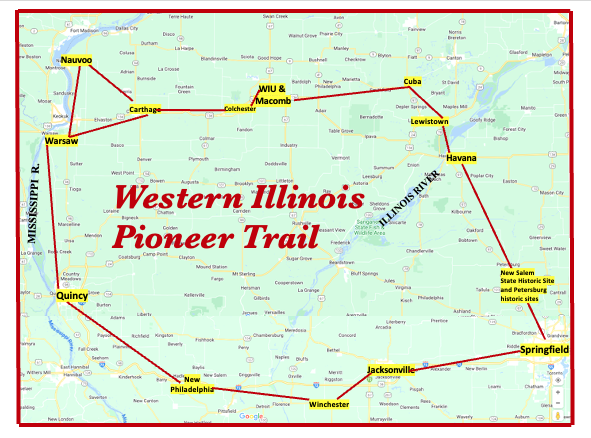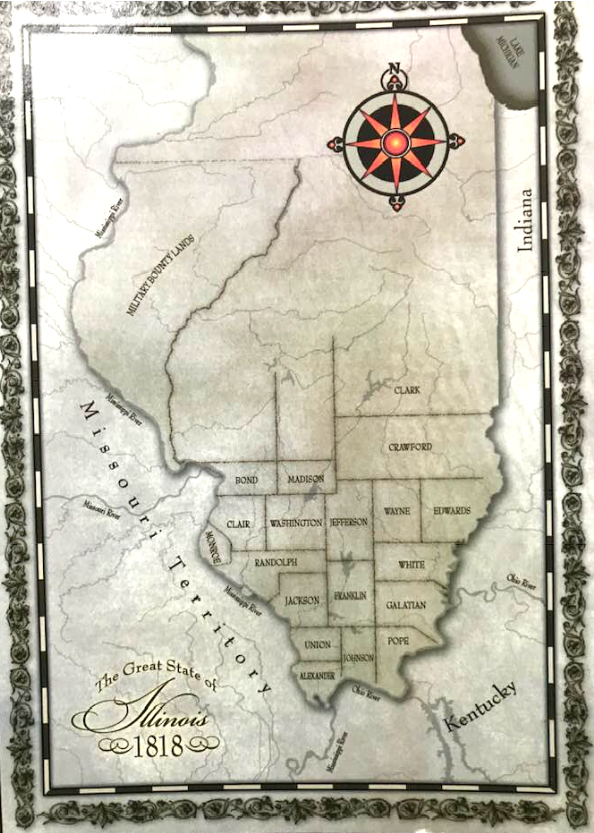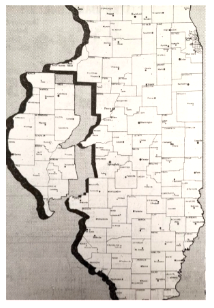The premise of this trail is to start at Springfield and move west past Jacksonville, with its excellent tourism program for the Underground Railroad, then continue to historic Winchester and then to New Philadelphia, founded by an African Slave who bought himself out of bondage and established an integrated town on the frontier. From there the route goes west to Quincy, a fascinating river town now nicknamed “City of Refuge” (because of the shelter it gave to Mormons and escaping slaves), then north along the Mississippi River to Warsaw, Nauvoo and Carthage. Quincy, Warsaw, Nauvoo and Carthage form a “Mormon quartet” of sites. The visitor next heads east to see Colchester. From there it is a short distance to Macomb where the exceptional Western Illinois Archives of Malpass Library are held on the campus of Western Illinois University. Macomb itself is a pretty town with a lovely square and fine courthouse. Still moving east, the visitor can enjoy Lewistown‘s Dickson Mounds (a Native American site with an excellent museum) and Oak Hill Cemetery (the basis of Edgar Lee Masters’ narrative poem, Spoon River Anthology). Crossing the beautiful bridge over the scenic Illinois River, and now heading south, the next stop is historic Havana. The penultimate stop on this pioneer trail is Lincoln’s New Salem. The route finishes where it started: Springfield. Or, one can do the route moving north from Springfield, then west, then south and then east back toward Springfield. We shall soon provide details of each town on the map.


CHRONOLOGY OF WESTERN ILLINOIS
Courtesy of Joe Conover (Quincy, IL)
What was known as the Illinois country was part of the French colony of Louisiana in 1717, was ceded to Britain by the Treaty of Paris in 1763, was secured for Virginia by George Rogers Clark in 1778 and was placed in the Northwest Territory by the Northwest Ordinance of 1787. There was military and civil exploration throughout the Illinois country in these years and there was conflict with native Americans.
1809 — Congress organizes the Illinois Territory out of the Indiana Territory, with Kaskaskia the capital and Ninian Edwards as governor. Abraham Lincoln is born Feb. 12, 1809, in a log cabin on Nolin Creek near Hodgenville, Kentucky, a son of Thomas and Nancy Hanks Lincoln.
1811 — New Madrid (MO.) earthquake, said to be the largest in U.S. history, damages Southern Illinois.
1812 — New Madrid tremors reoccur. After action by Congress, President Madison declares war on Great Britain.
1813 — Stephen A. Douglas was born April 23 in Brandon, Vermont, a son of Stephen Arnold and Sarah Fiske Douglass. (As an adult, Douglas dropped the second “s” of his surname.)
1814 — First newspaper, the Illinois Herald, is published at Kaskaskia. In September, Major Zachary Taylor establishes Fort Edwards in Hancock County at Spunky Point, later to be called Warsaw, overlooking the Mississippi River across from the mouth of the Des Moines River. On December 24, Treaty of Ghent ends the War of 1812.
1816 — The Thomas Lincoln family moves to Perry County, Indiana; first bank in Illinois, at Shawneetown, is chartered by the territorial legislature; Fort Armstrong is built at Rock Island.
1817 — War of 1812 veterans begin receiving 160-acre land warrants in the Illinois Military Tract, the region between the Illinois and Mississippi rivers. Frank McWorter, a slave hiring his own time from his Pulaski County, Kentucky, owner, buys the freedom of his wife, Lucy.
1818 — Illinois becomes the 21st state, with Kaskaskia the capital and Shadrach Bond the first governor. The state’s population is 34,620. Nancy Hanks Lincoln dies in Indiana of “milk sickness.”
1819 — Illinois Legislature passes the Illinois Black Code, also known as the Black Laws. Frank McWorter buys his own freedom and continues commercial farming, saltpeter manufacture and other entrepreneurial activities in frontier Kentucky for the next decade.
1821 — Pike County is established; encompasses all of Illinois north of the Illinois River. Following “Missouri Compromise” of 1820, Missouri is admitted to the Union as a slave state.
1822 — John Wood, a surveyor from New York State, builds the first cabin at what will become the city of Quincy.
1824 — Illinois voters defeat a constitutional convention call to permit slavery in the state.
1825 — Adams County is formed out of Pike County, and the two counties become their present size.
1829 — Dr. David Nelson, a native of Tennessee who served as a surgeon in the War of 1812, arrives in Marion County, Mo., and founds a manual labor college at Greenfields. Nelson, an abolitionist, gave up medicine for the Presbyterian ministry, and was ordained in 1825 at Rogersville, Tennessee.
1830 — Frank and Lucy McWorter arrive in Illinois from Kentucky. Abraham Lincoln, now 21, arrives in Logan County, Illinois, with his father Thomas and stepmother Sarah Bush Johnston Lincoln. The Rev. Asa Turner, a member of the “Yale (Theological Seminary) Band” pledged to missionary work in the Illinois wilderness, arrives in Quincy from Templeton, Massachusetts.
1831 — Frank McWorter settles in Hadley Township in Pike County. Abraham Lincoln leaves his parents in Coles County, hires on to take a flat boat of produce to New Orleans, then settles in New Salem. Orville Hickman Browning, a lawyer from Kentucky, settles in Quincy and opens a law practice.
1832 — Lincoln runs for the Illinois Legislature and loses. Black Hawk War takes place with John Wood, Orville Hickman Browning and others serving.
1833 — Dr. Richard Eells of Connecticut settles in Quincy to establish a medical practice, quickly acquires abolitionist sympathies. Stephen A. Douglas arrives in Illinois at Quincy in late autumn. He left his mother’s and step-father’s home in upstate New York in June, traveling to Cleveland, then down the Ohio River and up the Mississippi to St. Louis where, nearly out of cash, he bought an upriver steamboat ticket to Quincy.
1834 — Lincoln is elected to the Illinois Legislature and begins the study of law; gunsmith Jonathan Browning, inventor of repeating rifles, father of John Moses Browning and a cousin of Orville Hickman Browning, settles in Adams County near Quincy. An Association of Congregational Churches is formed in Quincy in the home of the Rev. Asa Turner in support of the abolitionist movement.
1835 — In June, Eells buys Lot No. 6, Block 19, and builds the now restored house at 415 Jersey; in November of this year, Jane Clemens gives birth to a son in Florida, Mo., that she and husband John Clemens name Samuel.
1836 — Frank McWorter records the plat of a town in Hadley Township that he names New Philadelphia, believed to be the first in the United States founded independently by a free African American; Lincoln is re-elected to the Legislature.
1837 — Now admitted to the Illinois bar, Lincoln moves to Springfield and begins the practice of law.
1838 — Dr. David Nelson, no longer welcome in Missouri, purchases land in Melrose Township, Adams County, for a residence he calls Oakland and a school that is the first Mission Institute. In Salem, Ind., in October, Helen Leonard Hay, wife of Dr. Charles Hay, gives birth to a son, John Milton Hay.
1839 — In February and March, members of the Church of Jesus Christ of Latter-day Saints flee Missouri under pain of “extermination” to encamp in John’s Square in Quincy; the John Clemens family moves from Florida, Mo., to Hannibal, and Springfield becomes the capital of Illinois.
1840 — The Latter-day Saints are established in the Hancock County city they call Nauvoo; Dr. David Nelson establishes Mission Institute No. 2 on 11 acres in the vicinity of 25th and Maine in Quincy.
1841 — Financially ruined “through securities which he signed for friends,” Dr. Charles Hay moves his family from Indiana to Warsaw, Illinois. John Milton Hay, now 3, begins schooling in the “little brick schoolhouse” on Warsaw’s Fourth Street.
1842 — Doctor Eells attempts to get a Missouri slave named Charlie to Mission Institute No. 2, but his buggy is pursued and he is arrested hours later on a charge of harboring a fugitive slave; in Springfield, Abraham Lincoln marries Mary Todd; Jonathan Browning, having earlier become a Latter-day Saint, moves to Nauvoo and builds a two-story brick residence and gun shop (now a museum)
1843 — In the spring of this year, Dr. Eells is fined $400 by Judge Stephen A. Douglas during Douglas’ regular court session in Quincy; later in the year the chapel at Mission Institute No. 2 is burned by a pro-slavery mob from Palmyra, Mo. Mary Todd Lincoln gives birth to a son, Robert. In December, the Illinois Supreme Court upholds the circuit court judgment against Dr. Eells.
1844 — John Clemens builds the Hill Street house in Hannibal that we now know as the Mark Twain boyhood home. Lincoln buys and occupies the only house he ever owns at Eighth and Jackson in Springfield. In February, Dr. Eells is selected as the Liberty Party’s candidate for Illinois governor. On June 27, Joseph Smith, the Latter-day Saints’ prophet, and his brother, Hyrum Smith, are assassinated in the Carthage jail. The abolitionist leader, Dr. David Nelson, dies on October 17 at Oakland, his farm east of Quincy.
1845 — The Donner party leaves Springfield by wagon train for California. During the fall, and into the early months of 1846, the settlement of Latter-day Saints known as Morley Town, in Hancock County’s Walker Township (near Tioga), is sporadically burned out by anti-Mormon vigilantes. One Edmund Durfee is murdered there.
1846 — The Latter-day Saints, including the Browning family, complete their exodus from Illinois and head West. On October 4, Dr. Eells dies “on the Ohio River near Cincinnati” on his way to Connecticut to seek advanced medical help.
1847 — John Clemens dies in Hannibal and Lincoln is serving a single term in the U.S. House of Representatives. Joseph Medill founds the Chicago Tribune. Stephen A. Douglas marries Martha Martin, daughter of a wealthy North Carolina planter.
1850 — The federal census of this year reports New Philadelphia has at least 11 residences and 58 people, with eight homes occupied by whites and a total of 36 persons, and three residences occupied by blacks with 22 persons, two of the three black families having one white person living in the household. The population of Illinois is 851,470.
1852 — In its December term, in Moore v. Illinois, the U.S. Supreme Court upholds the 1843 decision of the Illinois Supreme Court against Eells. The Eells estate was represented before the high court by Salmon P. Chase and William Seward, with George C. Dixon filing a written brief.
1853 — Martha Martin Douglas dies on January 19 after giving birth to a daughter who dies a few weeks later. Young Samuel Clemens leaves Hannibal for New York City; the first state fair is held in Springfield; the General Assembly enacts the Black Exclusion Act, another law intended to prevent free blacks from settling in Illinois. John Milton Hay enters Brown University.
1854 — Frank McWorter dies at New Philadelphia at the age of 77. Augustus Tolton is born to Peter Paul and Martha Jane Tolton on April 1 in Ralls County, Mo., the property of slave owner Steven Elliott.
1855 — Illinois General Assembly adopts a free public school system.
1856 — In November, Stephen A. Douglas marries Adele Cutts, a grand-niece of Dolley Madison.
1858 — In the fall of this year, Democrat Stephen A. Douglas and Republican (and former Whig) Abraham Lincoln hold public debates in Quincy and six other Illinois cities in campaigning for election to the U.S. Senate; Douglas is elected. John Hay is graduated from Brown University and returns to Pittsfield where he works in John Nicolay’s newspaper office until taking up the study of law in his uncle Milton Hay’s office in Springfield
1860 — Republican Abraham Lincoln is elected president of the United States, defeating three other candidates.
1861 — On Feb. 4, John Hay is admitted to the Illinois bar and a week later goes to Washington with President-elect Lincoln as an assistant private secretary. Martha Tolton takes Augustus, 7, his older brother and two younger sisters and flees Missouri across the Mississippi River. The family takes refuge in Quincy and Augustus attends Catholic schools. (Augustus Tolton is ordained on April 24, 1886, as the first known and recognized black priest in the United States. He dies in Chicago of heat stroke on July 9, 1897, and is buried in Quincy.)
1862 — The Palmyra (Mo.) Massacre occurs on October 18. Pro-Union forces execute 10 civilian prisoners with Confederate leanings after a Union spy disappears. Lincoln decries the slaughter.
1864 — Lincoln is re-elected president of the United States.
1865 — Lincoln is assassinated in Washington, D.C., and is buried in Springfield. Illinois General Assembly repeals the state’s Black Laws against black settlement and becomes the first state legislature to ratify the Thirteenth Amendment abolishing slavery. John Hay, at age 26, becomes Secretary of the U.S. Legation at Paris. Hay subsequently serves as Secretary of State under Presidents McKinley and Theodore Roosevelt, and in this office helps negotiate peace with Spain after the war of 1898; he authors McKinley’s “open door” policy toward China, and is instrumental in Roosevelt’s diplomacy leading to construction of the Panama Canal.
Forgottonia is the name given to a 16-county region in Western Illinois in the late 1960s and early 1970s. Forgottonia represented a protest against inequalities in state and federal funding of infrastructure (e.g. transportation), communications and economic development in the region after World War II.
This geographic region forms the distinctive western bulge of Illinois that is roughly equivalent to “The Tract”, the Illinois portion of the Military Tract of 1812. This wedge-shaped region lies between the Illinois and Mississippi rivers and, historically, it has been considered isolated (except for river bridge access) from the eastern portion of Central Illinois.

The name Forgottonia was created by Jack Horn, John Armstrong and Neil Gamm. The concept grew from the frustration of citizens and public officials of Western Illinois concerning the lack of support for regional transportation and infrastructure projects.
The term ‘’Forgottonia’’ was used again in 1980s by then Congressman (now Senator) Dick Durbin, who represented the southern portion of the region. He expanded the definition to include communications (educational television, fiber-optic routes, etc.) and infrastructure services (private and public). While the region’s name is less popular today, the exodus of population and industries has continued. Some counties in this region have reached federal poverty levels, for the first time in the state’s history.
[the text above is culled from Wikipedia]
Our project’s Western Illinois Pioneer Trail, if implemented, may be able to help some of the towns in Forgottonia.
We want to call attention to the extraordinary Forgottonia Project created by Cuba High School teacher, Joe Brewer (https://forgottoniaproject.com/).


